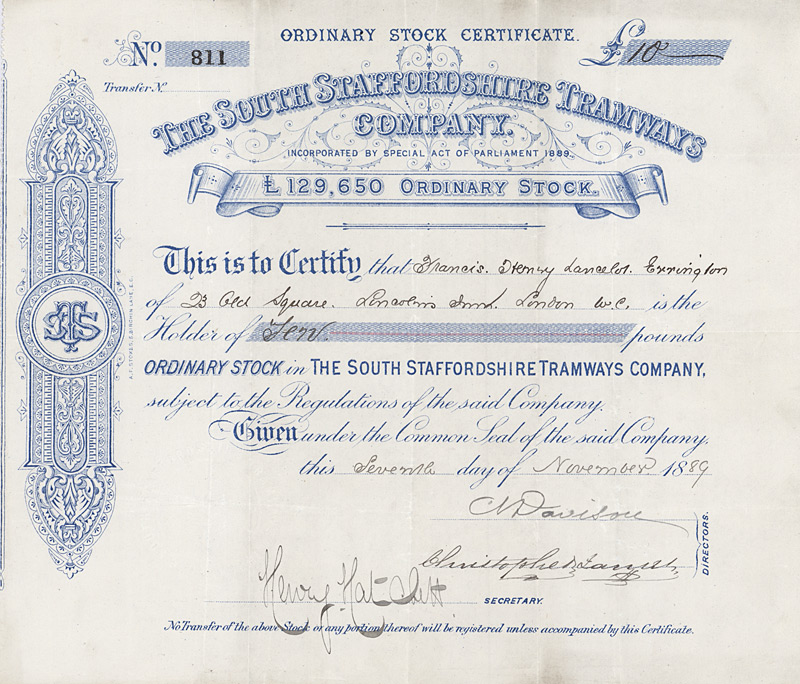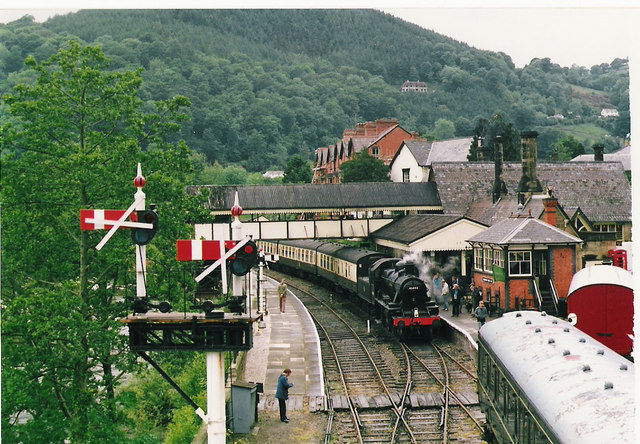|
Dudley, Stourbridge And District Electric Traction Company
The Dudley, Stourbridge and District Electric Tramways Company operated an electric tramway service between Dudley and Stourbridge and also other lines in the neighbourhood between 1899 and 1930. History On 2 April 1898 the Dudley and Stourbridge Steam Tramways Company was purchased by British Electric Traction A programme of modernisation was undertaken and the service was converted for electric traction. The first electric service ran on 26 July 1899. In April 1900 the company declared a net profit amount of £4,309 10s () for the year ending December 1899. The share capital of the company was £200,000 () divided into 20,000 5% cumulative preference shares of £5 each, and 20,000 ordinary shares of £5 each. By mid 1900 the British Electric Traction Company held 19,707 ordinary shares, of which 11,496 were purchased and the remainder allocated in part payment for the electrical conversion. Extensions were opened as follows: *19 October 1900 from Queen's Cross in Dudley t ... [...More Info...] [...Related Items...] OR: [Wikipedia] [Google] [Baidu] |
Black Country Living Museum
The Black Country Living Museum (formerly the Black Country Museum) is an open-air museum of rebuilt historic buildings in Dudley, West Midlands, England.Black Country Living Museum accessed 14 February 2011 It is located in the centre of the , 10 miles west of . The museum occupies of former industrial land partly reclaimed from a former railway goods yard, disused s, canal arm and former coal pits. The museum opened to the public in 1978, and has s ... [...More Info...] [...Related Items...] OR: [Wikipedia] [Google] [Baidu] |
Dudley
Dudley is a large market town and administrative centre in the county of West Midlands, England, southeast of Wolverhampton and northwest of Birmingham. Historically an exclave of Worcestershire, the town is the administrative centre of the Metropolitan Borough of Dudley; in 2011 it had a population of 79,379. The Metropolitan Borough, which includes the towns of Stourbridge and Halesowen, had a population of 312,900. In 2014 the borough council named Dudley as the capital of the Black Country. Originally a market town, Dudley was one of the birthplaces of the Industrial Revolution and grew into an industrial centre in the 19th century with its iron, coal, and limestone industries before their decline and the relocation of its commercial centre to the nearby Merry Hill Shopping Centre in the 1980s. Tourist attractions include Dudley Zoo and Castle, the 12th century priory ruins, and the Black Country Living Museum. History Early history Dudley has a history dating back ... [...More Info...] [...Related Items...] OR: [Wikipedia] [Google] [Baidu] |
Stourbridge
Stourbridge is a market town in the Metropolitan Borough of Dudley in the West Midlands, England, situated on the River Stour. Historically in Worcestershire, it was the centre of British glass making during the Industrial Revolution. The 2011 UK census recorded the town's population as 63,298. Geography Stourbridge is about west of Birmingham. Sitting within the Metropolitan Borough of Dudley at the southwestern edge of the Black Country and West Midlands conurbation, Stourbridge includes the suburbs of Amblecote, Lye, Norton, Oldswinford, Pedmore,Stambermill, Stourton, Wollaston, Wollescote and Wordsley. Much of Stourbridge consists of residential streets interspersed with green spaces. Mary Stevens Park, opened in 1931, has a lake, a bandstand, a cafe, and a mixture of open spaces and woodland. Bordered by green belt land, Stourbridge is close to countryside with the Clent Hills to the south and southwest Staffordshire and Kinver Edge to the west. Closest cities, tow ... [...More Info...] [...Related Items...] OR: [Wikipedia] [Google] [Baidu] |
Dudley And Stourbridge Steam Tramways Company
The Dudley and Stourbridge Steam Tramways Company operated a steam tramway service between Dudley and Stourbridge between 1884 and 1899. History The tramway was authorised by the Dudley, Stourbridge and Kingswinford Tramways Order of 1881. The line to Kingswinford was not approved. It opened on 21 May 1884 running from the London and North Western Railway Dudley railway station through Brierley Hill and Amblecote to Stourbridge. Fleet Locomotives: *1-8 Kitson and Company 1884 *9 Kitson and Company 1885 *10 Kitson and Company 1891 *11 Kitson and Company 1895 *12 Kitson and Company 1896 Eight passenger vehicles were ordered from the Starbuck Car and Wagon Company in 1884. On closure, five of these were transferred to the Birmingham and Midland Tramways Company. Closure The company was purchased by British Electric TractionThe Electrical review: Volume 40 on 2 April 1898, and converted to electric traction. The last steam tram ran on 25 July 1899 and the operation was taken ... [...More Info...] [...Related Items...] OR: [Wikipedia] [Google] [Baidu] |
British Electric Traction
British Electric Traction Company Limited, renamed BET plc in 1985, was a large British industrial conglomerate. It was once a constituent of the FTSE 100 Index but was acquired by Rentokil in 1996, and the merged company is now known as Rentokil Initial. History Early history Tramway services The company was founded in 1895 as British Electric Traction Company Ltd, with Sir Charles Rivers Wilson as chairman and Emile Garcke as managing director. It was involved in the electrification of tramways in British towns and cities, and also in Australia and New Zealand, for example in Auckland. From operating trams, BET moved on to manufacturing them with the purchase of Brush Electrical Engineering Company in 1901. The BET became the largest of the private owners of tramways in the British Isles. During its history, it gained control in England of the Metropolitan Electric and South Metropolitan systems in London, as well as systems in Barnsley, Barrow-in-Furness, Birmingham ... [...More Info...] [...Related Items...] OR: [Wikipedia] [Google] [Baidu] |
Blackheath, West Midlands
Blackheath is a town and ward in the Rowley Regis area of the Sandwell Metropolitan Borough, in the county of West Midlands, England. Establishment Before 1841, ''Bleak Heath'' or ''Blake Heath'' was a small group of farm houses and inns on the turnpike road from Oldbury to Halesowen, within Rowley Regis. The changes brought about by the industrial revolution led to a Private Act in June that year that allowed the sale of the Rowley Regis glebe lands in order to finance the building of a new vicarage. The land was purchased by developers who, throughout the remainder of the 19th century, expanded ''Blackheath'' as a dormitory town for the surrounding industries, in particular, the coal mine at Coombes Wood and the Hailstone quarry. Workers migrated to Blackheath from across England and particularly from Wales until the town and its neighbours grew to form the existing conurbation with nearby Birmingham. Churches The parish of St Paul was established in 1865 as a distinct ... [...More Info...] [...Related Items...] OR: [Wikipedia] [Google] [Baidu] |
Kinver Light Railway
The Kinver Light Railway operated a passenger and freight tramway service between Amblecote and Kinver, in South Staffordshire, between 1901 and 1930. History The Kinver Light Railway was a subsidiary of British Electric Traction. They acquired the Dudley and Stourbridge Steam Tramways Company in April 1898 and applied to the Light Railway Commissioners (in preference to the Tramways Act 1870) for permission to build a tramway from Amblecote to Kinver. The tramway was a single track with passing places. The route ran from outside the Fish Inn at Amblecote where it had a connection with the Dudley, Stourbridge and District Electric Traction Company tracks. After passing Wollaston and Stourton, it arrived in Kinver. From Amblecote to Wollaston Ridge it ran on the streets using conventional grooved rail. From there the line used Vignoles rail (non-grooved bullhead rail). The use of Vignoles rail in conjunction with the tramway’s tight curves led to the Board of Trade Insp ... [...More Info...] [...Related Items...] OR: [Wikipedia] [Google] [Baidu] |
South Staffordshire Tramways Company
The South Staffordshire and Birmingham District Steam Tramways Company which became the South Staffordshire Tramways Company operated a tramway service from their depot in Wednesbury between 1883 and 1924. South Staffordshire and Birmingham District Steam Tramways Company The Staffordshire Tramways Order of 1879 authorised the construction of the steam tramway which was operated by the South Staffordshire and Birmingham District Steam Tramways Company. The company depot was at Kings Hill, Wednesbury. Routes and start dates were as follows: *16 July 1883 New Inns Handsworth and Darlaston, via West Bromwich and Wednesbury. *14 January 1884 Carter's Green West Bromwich to Great Bridge *21 January 1884 Wednesbury to Dudley, via Tipton *21 January 1884 Darlaston to Moxey *4 December 1884 Wednesbury to Bloxwich, via Pleck and Walsall, *4 December 1884 Darlaston to Pleck, *4 December 1884 an extension from Walsall to Mellish Road *12 October 1885 Great Bridge to Dudley *21 November 1 ... [...More Info...] [...Related Items...] OR: [Wikipedia] [Google] [Baidu] |
Amblecote
Amblecote is an urban village and one of the most affluent areas in the Metropolitan Borough of Dudley in the West Midlands, England. It lies immediately north of the historic town of Stourbridge, extending about one and a half miles from it, and is on the southwestern edge of the West Midlands conurbation. Historically, Amblecote was in the parish of Oldswinford, but unlike the rest of the parish (which was in Worcestershire) it was in Staffordshire, and as such was administered separately. Formerly an urban district in its own right, Amblecote was divided between the boroughs of Dudley and Stourbridge in 1966, with the area to the east of the railway line becoming part of Brierley Hill and the remainder going into Stourbridge. This is reflected in the area's postcodes, being split between the DY5 and DY8 postal districts. In 1974, under the Local Government Act, the entirety of Amblecote became part of the Metropolitan Borough of Dudley, in the new West Midlands county. His ... [...More Info...] [...Related Items...] OR: [Wikipedia] [Google] [Baidu] |
Llangollen Railway
The Llangollen Railway () is a volunteer-run heritage railway in Denbighshire, North Wales, which operates between Llangollen and Corwen. The standard gauge line, which is long, runs on part of the former Ruabon – Barmouth GWR route that closed in 1965. It operates daily services in the summer as well as weekends throughout the winter months, using a variety of mainly ex-GWR steam locomotives as well as several diesel engines and diesel multiple units. A extension of the railway has been built to complete the line to Corwen. In March 2021 the railway company announced that, having made a loss in three consecutive years, they had invited their bank to appoint receivers. History Commercial Service: 1865–1962 Llangollen was already a popular place for tourists by the 1840s. Travel up to this time had been by horse-drawn carriage, but by the 1840s the Shrewsbury to Chester line had been completed, which allowed passengers to alight at (later known as Whitehurst Halt), an ... [...More Info...] [...Related Items...] OR: [Wikipedia] [Google] [Baidu] |
Tram Transport In England
A tram (called a streetcar or trolley in North America) is a rail vehicle that travels on tramway tracks on public urban streets; some include segments on segregated right-of-way. The tramlines or networks operated as public transport are called tramways or simply trams/streetcars. Many recently built tramways use the contemporary term light rail. The vehicles are called streetcars or trolleys (not to be confused with trolleybus) in North America and trams or tramcars elsewhere. The first two terms are often used interchangeably in the United States, with ''trolley'' being the preferred term in the eastern US and ''streetcar'' in the western US. ''Streetcar'' or ''tramway'' are preferred in Canada. In parts of the United States, internally powered buses made to resemble a streetcar are often referred to as "trolleys". To avoid further confusion with trolley buses, the American Public Transportation Association (APTA) refers to them as "trolley-replica buses". In the United ... [...More Info...] [...Related Items...] OR: [Wikipedia] [Google] [Baidu] |






